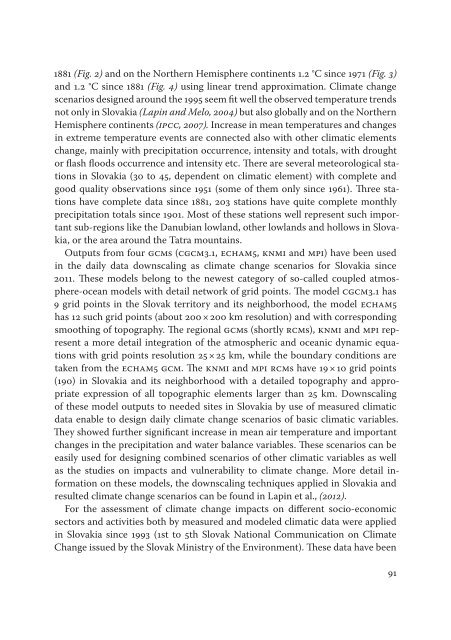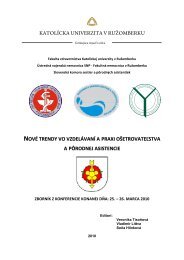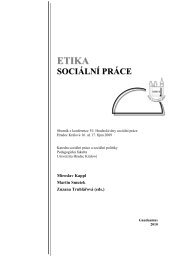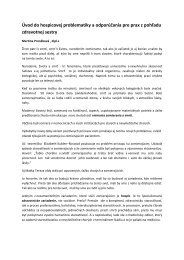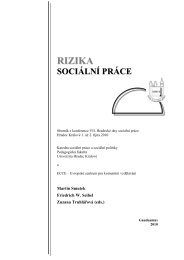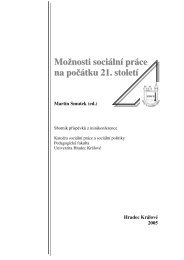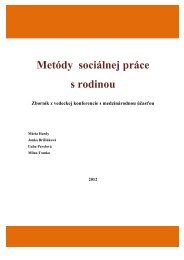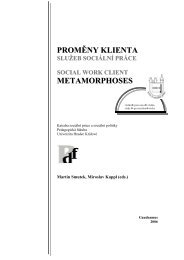Zmena klÃmy â možný dopad (nielen) na obyvateľstvo - Prohuman
Zmena klÃmy â možný dopad (nielen) na obyvateľstvo - Prohuman
Zmena klÃmy â možný dopad (nielen) na obyvateľstvo - Prohuman
You also want an ePaper? Increase the reach of your titles
YUMPU automatically turns print PDFs into web optimized ePapers that Google loves.
1881 (Fig. 2) and on the Northern Hemisphere continents 1.2 °C since 1971 (Fig. 3)<br />
and 1.2 °C since 1881 (Fig. 4) using linear trend approximation. Climate change<br />
sce<strong>na</strong>rios designed around the 1995 seem fit well the observed temperature trends<br />
not only in Slovakia (Lapin and Melo, 2004) but also globally and on the Northern<br />
Hemisphere continents (IPCC, 2007). Increase in mean temperatures and changes<br />
in extreme temperature events are connected also with other climatic elements<br />
change, mainly with precipitation occurrence, intensity and totals, with drought<br />
or flash floods occurrence and intensity etc. There are several meteorological stations<br />
in Slovakia (30 to 45, dependent on climatic element) with complete and<br />
good quality observations since 1951 (some of them only since 1961). Three stations<br />
have complete data since 1881, 203 stations have quite complete monthly<br />
precipitation totals since 1901. Most of these stations well represent such important<br />
sub-regions like the Danubian lowland, other lowlands and hollows in Slovakia,<br />
or the area around the Tatra mountains.<br />
Outputs from four GCMs (CGCM3.1, ECHAM5, KNMI and MPI) have been used<br />
in the daily data downscaling as climate change sce<strong>na</strong>rios for Slovakia since<br />
2011. These models belong to the newest category of so-called coupled atmosphere-ocean<br />
models with detail network of grid points. The model CGCM3.1 has<br />
9 grid points in the Slovak territory and its neighborhood, the model ECHAM5<br />
has 12 such grid points (about 200 × 200 km resolution) and with corresponding<br />
smoothing of topography. The regio<strong>na</strong>l GCMs (shortly RCMs), KNMI and MPI represent<br />
a more detail integration of the atmospheric and oceanic dy<strong>na</strong>mic equations<br />
with grid points resolution 25 × 25 km, while the boundary conditions are<br />
taken from the ECHAM5 GCM. The KNMI and MPI RCMs have 19 × 10 grid points<br />
(190) in Slovakia and its neighborhood with a detailed topography and appropriate<br />
expression of all topographic elements larger than 25 km. Downscaling<br />
of these model outputs to needed sites in Slovakia by use of measured climatic<br />
data e<strong>na</strong>ble to design daily climate change sce<strong>na</strong>rios of basic climatic variables.<br />
They showed further significant increase in mean air temperature and important<br />
changes in the precipitation and water balance variables. These sce<strong>na</strong>rios can be<br />
easily used for designing combined sce<strong>na</strong>rios of other climatic variables as well<br />
as the studies on impacts and vulnerability to climate change. More detail information<br />
on these models, the downscaling techniques applied in Slovakia and<br />
resulted climate change sce<strong>na</strong>rios can be found in Lapin et al., (2012).<br />
For the assessment of climate change impacts on different socio-economic<br />
sectors and activities both by measured and modeled climatic data were applied<br />
in Slovakia since 1993 (1st to 5th Slovak Natio<strong>na</strong>l Communication on Climate<br />
Change issued by the Slovak Ministry of the Environment). These data have been<br />
91


